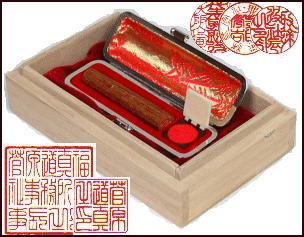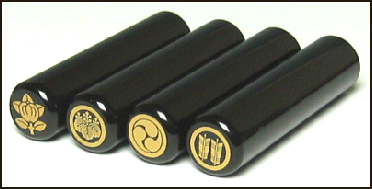NAMES IN JAPAN

hankos Japanese have family names and given names, used in that order. (English-language newspapers and magazines in Japan, however, usually present names in the order common among Western cultures, with given name first.) When addressing another person it is common to use “san” — the equivalent of Mr., Mrs. (or Ms.) — after the family name. The suffix “chan “is often attached to children’s names and given names of close friends. Other titles, such as “sensei “for “teacher” or “doctor,” are also attached as suffixes after the family name. Given names and their Chinese characters are chosen for their auspicious meanings and happy associations in the hope that they will bring the child good luck. As of 2010, the government has authorized a total of 2,930 characters for use in given
Japanese don't have middle names. Many didn't have family names until 1870 when the government required Japanese to take them as part of reform efforts to catch up with the West. Many female Japanese have a given names that end in the suffix "ko," a diminutive expression that means "little" and is sort of like the "ito" suffix in Spanish. "Akiko" and "Yoko" are diminutive versions of the given names Aki and Yo.
There are lots of Japanese male names. Many of the names are long and difficult for Westerners to remember. There are fewer females and they are shorter and easier to remember. Using a first name implies intimacy in English but is regarded as presumptuous, too familiar and rude in Japan and is called “yobisute” (“throwing the name away”).
When Japanese write their names in Japanese they write their family name first and their given name second, but reverse the order when they write their name in Roman letters (a practice that reportedly began when Japanese first had wide contact with foreigners in the late 1800s). In contrast, Chinese and Koreans, usually write their family names first in their native language and in English.
A woman named Nakamura Aya in Japan, for example, would call herself Aya Nakamura in the United States. On her business cards she would write Nakamura Aya in Japanese on one side and Aya Nakamura in English on the other. Her name would be written Aya Nakamura if it appeared in English-language textbooks or newspapers.
The matter is far from settled. In September 2000, the Education Ministry recommended that foreign-language textbooks, government publications and newspapers begin using Japanese word order for Japanese names.
Links in this Website: JAPANESE LANGUAGE Factsanddetails.com/Japan ; JAPANLISH AND ENGLISH IN JAPAN Factsanddetails.com/Japan ; NAMES IN JAPAN AND HANKOS Factsanddetails.com/Japan ; Good Websites and Sources: Names Behind the Name behindthename.com ; Female Japanese Names 20000-names.com ; Male Japanese Names 20000-names.com ; Translate Your Name to Japanese japanesetranslator.co.uk ;Wikipedia article on Japanese Names Wikipedia ; FAQs About Japanese Names sljfaq.org/afaq/names ;Surname Info japanorama.com
Japanese Names and Titles
People should be addressed by their titles and their family names plus an honorific (usually "san"). Honorifics have their roots ion their Middle Ages when they were strictly based on social hierarchy. After World War II when Japanese society became more democratized they were used in accordance with levels of intimacy between speakers.
Japanese should ideally be addressed by Westerners with Mr., Mrs., Miss or by adding the suffix “"san"” to the last name. Japanese use the suffix san even with neighbors and friends they have known for years. Some young or Americanized Japanese are comfortable being addressed by their first names or an English nickname.
Common titles include “sensei” (teacher or professor), “oishasan” (doctor), “untenshusan” (taxi driver), “omawarisan” (policeman). Within companies people are often addressed by their titles — chairman, president, manager, section manager, supervisor, etc.”rather than name. The teacher Aya Nakamura is called Nakayamura-san (Ms. Nakamura) by her boss and Nakamura Sensei or Sensei by her students. Some of her friends might call her Aya-chan. "Chan" is a suffix usually used with the first names of children, good friends and sometimes with dogs or other pets.
In addressing someone in the second person, Japanese have traditionally had to take into account age, circumstance, gender, social position and other factors to decide which verb endings, adjectives and words to use. This is not as true today with the exception of people using more respectful language when talking to older people or addressing people in formal situations.
Attitude in Japan Towards Names and Titles

hankos In the late 1980s many companies began replacing the name system in which employees addressed one another by their family names and title with a system using family names and “san” as on attempt to facilitate communications by breaking down some of the barriers of hierarchy. Many employees had difficultly adapting to the changes.
Breaches of name and title etiquette can sometimes have deadly consequences. In 1975, two workers with the Elpida Company — 30-year-old Kunihiro Fukada and 27-year-old Tomohiko Okabe — were having a drink at a bar in Tokyo. Even though Okabe was younger than many of his co-workers he often addressed co-workers that were older than him with language used for people younger because he entered the company earlier them. He did this with Fukada. Fukada took offense and Okabe said, “What’s wrong if a senior guy calls his junior in this way?” Outraged. Fukada grabbed Okabe’s neck, pummeled his face and killed him.
Over time Japan has become less formal. Some companies have even issued orders to their employees to stop addressing one another by their titles but to simply add the suffix -san to their names. Parents and teachers no longer expect their children to use honorific language. Many older Japanese see the change as a coarsening of their language and society.
Japanese Maiden Names
Japanese law requires a married couple to have one family name. Ninety-nine percent of all couples choose the man's name (those that take the woman's name usually do so if the woman's family is rich or has a respected name). Married women who adopt their husband's name are required to use that name on passports, drivers licenses, airplane tickets, registered mail and government forms.
In practice some married women use their husband's name in some situations and their maiden name in other situations that in some cases vary from individual to individual. Many working women, for example, use their maiden names in their professional lives and only use their husband's surname on official documents. Sometimes confusion over names causes serious problems. Some women have had their vacation ruined because their husbands ordered planes tickets using their maiden name and the women were not able to check in because the name on their ticket was different from the name on their passport.
In an effort to avoid confusion the government has proposed standardizing maiden name use to eight specific cases: work place names; seating configurations; work rosters; in-house telephone directories; bylines for original articles; names used in transfer notices; attendance books; and books of holiday records.
The Democratic Party of Japan government elected in August 2009 wants to introduce legislation that allows married couples to use separate surnames, changing Japan’s the nation’s Civil Code. The plan died after one of the ruling party’s small coalition partners vehemently opposed it. A government survey on the issue in 2011 found that 37 percent of the respondent supported a revision of the law while 35 percent were against it.
The law that requires most women to drop their maiden names and assume their husband’s name dates back to 1898. In February 2011, a four women and one man filed a suit in the Tokyo District Court claimed that the law breached the constitutional guarantee of equal rights for both spouses. The group is demanding about $65,000 in damages, one of the four women, 75-year-old Kyoko Tsukamoto, said that using her husband name for hadlfa century was “like having a splinter in my heart,” adding “I want to die Kyoko Tsukamoto. She said she uses here maiden name in daily life but uses her husband’s surname on legal documents.
On rare occasions men take their wives’ family names, for instance, when they come from noble families.
Japanese Family Names
Suzuki is the most common family name, with Satos a close number two. According to estimates there around 2.2 million Suzukis and 2.1 million Satoses. Other common names include Tanaka, Nakamura, Nakayama.
Some Suzukis attend Suzuki gatherings and listen to Suzukiologists give speeches about what makes Suzikis so special. Banks use names with Suzuki the same way John Doe is used in the United States. According to one count 40 presidents, 345 directors of large companies and 10,000 chief executives of smaller companies possess the name Suzuki as well as a number of famous artists, scientists, actors and athletes (such as baseball player Ichiro Suzuki).
Some Suzukis trace their name 65 generations to a 12th-century samurai named Saburo Shigeie Suzuki. Many others can only trace their name back to 1870 when their great-great-great grandparents were required by law to take a second name.
Japanese First Names
The kanji (Chinese character) spelling of a first name is very significant. When mothers with children meet for the first time the kanji spelling of the child’s name is usually the third thing mothers ask about after the name and age of a child.
Common girl’s names and their meanings: Ayaka (“Colorful Flower/fragrant/ Summer”); Ayumi (‘stroll”); Chie (“Wisdom” or “Thousand Blessings”); Emi (‘smile”); Hitomi (“Pupil” of the Eyes and Is Usually Given to Girls with Exceptionally Beautiful Eyes); Kaori (“Fragrance”); Keiko (Blesses, Respectful Child”); Mai (“Dance”); Miki (“Beautiful Tree” or “Three Trees); Masako (“Correct, Giving Child”); Miho (“Beautiful Bay”); Momoka (“Peach Child”); Nana (‘seven”); Yoko (“Ocean Child”); Yuko (“Helpful, Superior Child”); Akiko (“Autumn Child” or “Bright Child”).
Hiroto for a boy and Aoi for a girl wee the top names in 2007. The Chinese character for Hiroto means “big” and “flying the air.” Other common boy’s names and their meanings include: Hiro (“broad” or “widespread”); Jun (“Obedient”); Naoki (“Honest Tree”); Sora (‘sky”); and Yoshi (“Good”).
Hankos (Signature Chops)

hankos Instead of signing their name, Japanese stamp their name on forms, bank withdrawal slips and letters with a “hanko” (chop, or signature stamp). Without a hanko one can't open a bank account in Japan or register for a university class. One professor told the Los Angeles Times, "I don't exist in this society without my hanko." [Source: Mark Magnier, Los Angeles Times, November 28, 2001]
Hankos are cylinders about the size of a piece of chalk. They have the person’s name carved at one end in Chinese characters and they leave an imprint after being stamped in ink. Everyone from the Emperor to a homeless man living in a park has a hanko, and they are used for everything from finalizing a multi-million-dollar business deal to signing for packages delivered to one’s house.
The average Japanese has five hankos but only one is registered with the government to certify ownership and it is only used on important documents. Since these seals are considered too valuable to carry around, people have other seals to use for things like bank transactions and taking deliveries. Many government documents have several hanko stamps. According one estimate a typical bureaucrats puts his hanko on 100,000 documents in a 25 year career.
Hankos have a 5,000 year history. Signature seals, which operates according the same concept, were used in ancient Mesopotamia and China. Japan's oldest example of writing is a solid-gold hanko dated to A.D. 57.
In the 8th century, only the Emperor was allowed to use a hanko. Later members of the Imperial court and noblemen started using them. The samurai class gained access to them in the Middle Ages. Ordinary Japanese didn't start using them until the Meiji period in the mid-19th century.
Good Websites and Sources: Hankos Wikipedia article on East Asian Seals Wikipedia ; Art of the Chinese Chop csymbol.com/stamp ; History of Chinese Seal Carving char4u.com ; Introduction to Seal Carving arranke.blogspot.com ; Hanko Stamp jun-gifts.com ; Hanko Designs hankodesigns.com ; The Japanese Connection thejapaneseconnection.com
Types of Hankos in Japan

hankos A hanko can cost as little as ¥80 or as much ¥1 million. Some of the most expensive have traditionally been made with ivory.
Much of the ivory from poached elephants that found its way to Japan in the 1980s was used for making hankos. When the Japanese economy was at its peak in the late 1980s, ivory hanko were such a status symbol they were the primary destination of elephant tusk ivory. Forty percent of the ivory poached from Africa in the 1980s ended up in Japan, compared to 15 percent in the United States and 20 percent in Europe.←
Men’s hankyo’s are usually larger than women's and usually larger than their subordinates. The most secure ones are used in banking and real estates deals.
Cheap discount store varieties are used for accepting packages and signing routine registration forms. They usually only have the person's family name. More expensive have the family name and the surname arranged in a unique way.
Hand carved hankos typically cost about ¥8,000 at a small hanko shop. These days most are made with computers and automated cutting tools. It is believed that only a few hanko craftsmen will be left in a few years.
Hanko Forgery and Theft
One of the biggest problems with hankos is forgery and theft. Criminals and people burdened by heavy debts have stolen hankyos and put the chop of their owners on insurance polices, loan papers and real estate documents.
Computers can be used to match a hankyo mark against the original but technology — namely scanners and computer-operated engraving equipment — has made it possible to forge a hankyo from a sample mark.
Some people have become so worried about hanko fraud there has been discussion of adopting signatures. Other don’t think his will ever happen. One office worker told the Los Angeles Times, "I just don't feel comfortable signing something. If I do, I end up putting a circle around it. We're just a hanko society."
In extreme cases families have discovered their property has been sold with a stolen hanko and elderly people have found their savings accounts emptied by nurses who cared for them. In some cases some people have been murdered after the hanko was stamped on a life insurance policy taken out by the murderer.
In the early 2000s, there were a series of crimes in which thieves broke into homes and stole bankbooks and then used hankyos purchased at stores to withdraw millions of yen from the account. There have also been thefts of account books, which until recently carried imprints of the account holder’s seals, giving access to thousand of hankyo marks.
People have been also been screwed by their spouses and relatives and financial advisors. One divorcee said he discovered her seal on a loan after her husband had disappeared. Others were cheated by financial advisors who said they need the hankyos to make seals in complicated paper work. There have also been reports of elderly people with dementia being tricked to put their signature on documents.
Image Sources: Goods from Japan
Text Sources: New York Times, Washington Post, Los Angeles Times, Daily Yomiuri, Times of London, Japan National Tourist Organization (JNTO), National Geographic, The New Yorker, Time, Newsweek, Reuters, AP, Lonely Planet Guides, Compton’s Encyclopedia and various books and other publications.
Last updated August 2012
